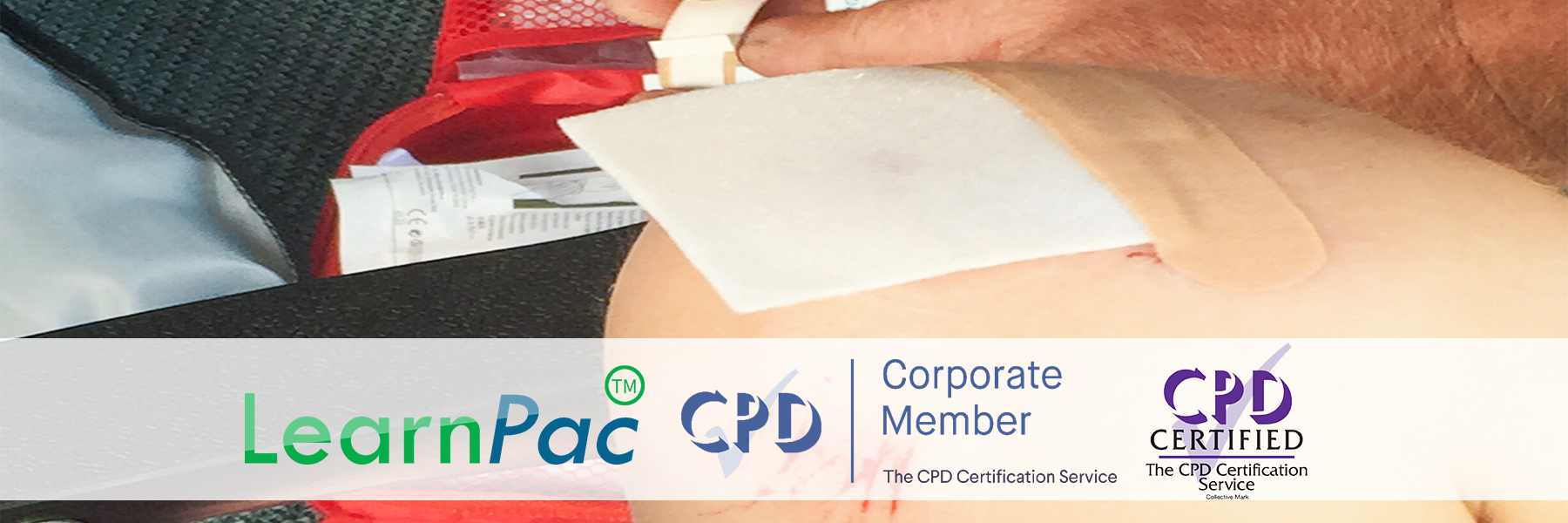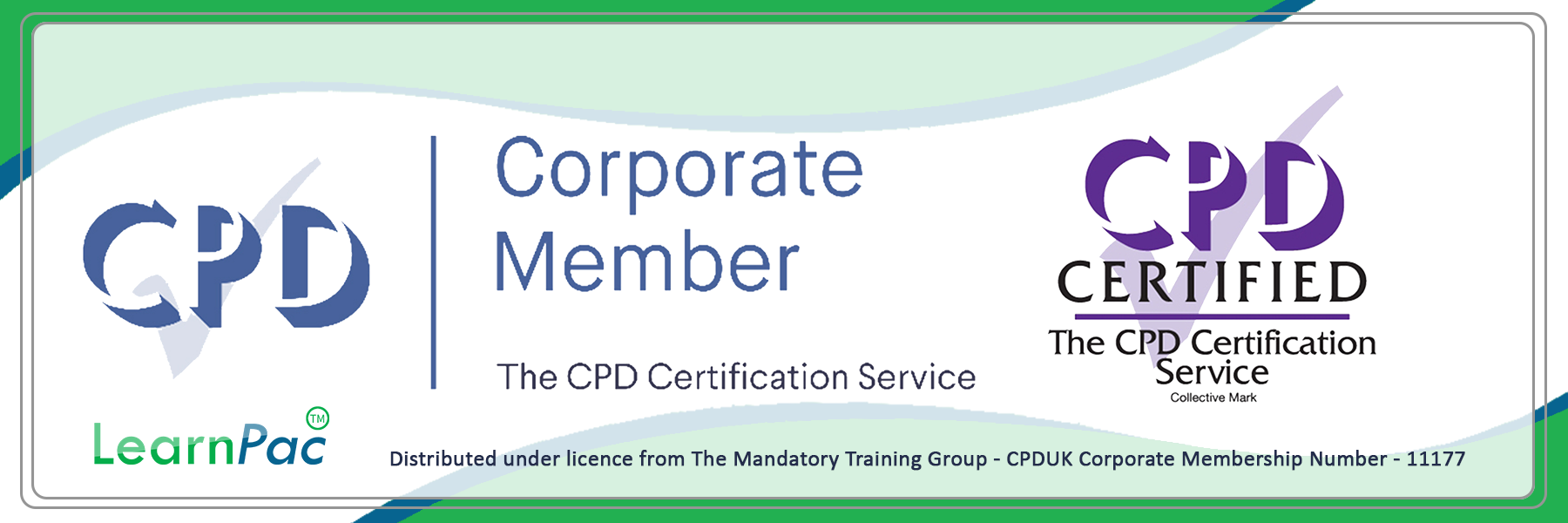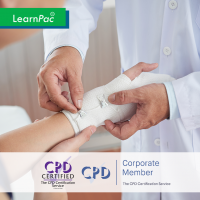Wound Care Training - E-Learning Courses - CPD Accredited

Wound Care Training – E-Learning Courses with Certificates – CPDUK Accredited.
LearnPac Systems is the leading UK provider of accredited online training courses, programmes and qualifications. Our interactive learning management system (LMS) can easily be customised to individual organisations, regardless of the size or sector.
Wounds can range from a light scratch to deep damage of tissue and muscle and within your role in health and social care, you may come into contact with different types of wounds regularly. Without correct management, a wound can quickly worsen and deteriorate.
This comprehensive wound care training will expand your understanding of wound management, assisting you to respond appropriately to support healing and promote wellbeing. A ‘must have’ for induction, refresher, management and vocational training.
Browse our Wound Care Training - E-Learning Courses
Wound Care Training: Frequently Asked Questions and Answers
Wound Care Training – E-Learning Courses with Certificates – CPDUK Accredited – LearnPac Systems UK.
Here at LearnPac Systems, we receive many questions about wound care. We have provided answers to the most frequently asked questions about wound care training.
Click on the text below to see the answers to the Frequently Asked Questions about Wound Care.
A wound is a serious injury, especially a deep cut through the skin. But things like pride and feelings can also get wounded.
LearnPac Systems is the leading UK provider of accredited online training courses, programmes and qualifications. Our interactive learning management system (LMS) can easily be customised to individual organisations, regardless of the size or sector.
Click here for Wound Care Training – E-Learning Courses – CPD Certified
Wounds fall into two broad categories: open or closed.
LearnPac Systems is the leading UK provider of accredited online training courses, programmes and qualifications. Our interactive learning management system (LMS) can easily be customised to individual organisations, regardless of the size or sector.
Click here for Wound Care Training – E-Learning Courses – CPD Certified
An open wound is any internal or external injury that leaves inner tissue exposed to the external environment. People can sometimes treat acute open wounds at home with medications and natural remedies.
In a closed wound, tissue damage and bleeding occur under the surface of the skin. Examples of closed injuries include bruises.
Examples of open wounds include the following:
- Abrasion
- Laceration
- Avulsion
- Puncture
- Incision.
To obtain wound care certification, you must have at least three years of wound care experience. If you are a nurse with a Bachelor’s degree and do not have three years of experience, determine if you are eligible via the experiential pathway through the W.O.C.N.C.B.).
First, wash and disinfect the wound to remove all dirt and debris. Use direct pressure and elevation to control bleeding and swelling. When wrapping the injury, always use a sterile dressing or bandage. Minor wounds may heal without a bandage.
LearnPac Systems is the leading UK provider of accredited online training courses, programmes and qualifications. Our interactive learning management system (LMS) can easily be customised to individual organisations, regardless of the size or sector.
Click here for Wound Care Training – E-Learning Courses – CPD Certified
Airing out most wounds isn’t beneficial because injuries need moisture to heal. Leaving a wound uncovered may dry out new surface cells, which can increase pain or slow the healing process. This keeps new skin and other cells alive. It also helps protect the area from dirt, germs and further injury.
If you notice any of these signs of infection, call your doctor right away:
- Expanding redness around the wound
- Yellow or greenish-coloured pus or cloudy wound drainage
- Red streaking spreading from the wound
- Increased swelling, tenderness, or pain around the wound.
- Fever.
The wound care, ostomy, or continence and foot care nurse (also referred to as a WOC nurse) specializes in assessing and treating skin breakdown and wounds, especially pressure ulcers. They often cross-train in the care of ostomies.
Use direct pressure and elevation to control bleeding and swelling. When wrapping the wound, always use a sterile dressing or bandage. Minor wounds may heal without a bandage. You’ll need to keep the wound clean and dry for five days.
LearnPac Systems is the leading UK provider of accredited online training courses, programmes and qualifications. Our interactive learning management system (LMS) can easily be customised to individual organisations, regardless of the size or sector.
Click here for Wound Care Training – E-Learning Courses – CPD Certified
Several types of interactive products are:
- Semi-permeable film dressings
- Semi-permeable foam dressings
- Hydrogel dressings
- Hydrocolloid dressings
- Alginate dressings.
The wound healing stages are made up of three basic phases:
- Inflammation
- Proliferation
- Maturation.
People can take over-the-counter (O.T.C.) pain medications to reduce inflammation and painful symptoms during the healing process. Avoid aspirin, however, as it can cause bleeding and delay the wound healing process.
A healthcare provider may prescribe stronger pain relievers for people with severe or infected wounds.
People can use topical antibiotics on minor cuts and scrapes. A healthcare professional may prescribe oral antibiotics if they believe that someone has a high risk of developing an infection while healing.
Wounds can range from a light scratch to deep damage of tissue and muscle and within your role in health and social care, you may come into contact with different types of wounds regularly.
Without correct management, a wound can quickly worsen and deteriorate. This comprehensive wound care training will expand your understanding of wound management, assisting you to respond appropriately to support healing and promote wellbeing.
A ‘must have’ for induction, refresher, management and vocational training.
Wound care training is aimed at professionals such as nurses, healthcare assistants and practitioners working in a clinical environment.
LearnPac Systems is the leading UK provider of accredited online training courses, programmes and qualifications. Our interactive learning management system (LMS) can easily be customised to individual organisations, regardless of the size or sector.
Click here for Wound Care Training – E-Learning Courses – CPD Certified
Below are some of the duties and responsibilities of a wound care nurse:
- The wound care nurses have to treat the skin reactions of the patients.
- They have to treat or manage vascular ulcers, diabetic ulcers and all the other types of ulcers.
- Treat all the types of open wounds, scars or skin infections.
- Preventing skin breakdown.
Wounds can range from a light scratch to deep damage of tissue and muscle and within your role in health and social care, you may come into contact with different types of wounds regularly. Without correct management, a wound can quickly worsen and deteriorate.
This comprehensive wound care training course will expand your understanding of wound management, assisting you to respond appropriately to support healing and promote wellbeing.
Yes, our wound care training courses are externally peer-reviewed and accredited by the CPD Certification Service (CPDUK). The Mandatory Training Group work with the CPD Certification Service to develop and accredit comprehensive content in line with current UK legislation, regulatory framework and recommendations from professional organisations. Click here to see our CPDUK accreditation credentials.
LearnPac Systems is distributed under the licence from The Mandatory Training Group – CPDUK Corporate Memebrship Number – 1117
LearnPac Systems is the leading UK provider of accredited online training courses, programmes and qualifications. Our interactive learning management system (LMS) can easily be customised to individual organisations, regardless of the size or sector.
Click here for Wound Care Training – E-Learning Courses – CPD Certified




